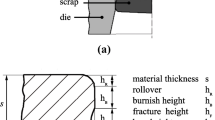Abstract
The quality evaluation of a wooden surface machined by peripheral milling can be achieved by means of the visual assessment or by surface roughness measurement. The method defined in this paper is a novel alternative to the state-of-the-art material machine-ability evaluation providing objective results acquired by an automatic system. Critical machining conditions and surface defects are stimulated by a purposely-designed circular sample. The approach proposed bases on a multi-sensor technology where a laser triangulation system reconstructs the 3D surface topography and a camera records the grayscale image of the same surface while the sample is rotated around a central axis. The dedicated software allows automated surface reconstruction, quality assessment and the detection of specific defects. The method is rapid and allows an easy comparison of different cutting conditions intended as a tool to rapidly determine optimal solutions.








Similar content being viewed by others
References
Aknouche H, Goli G, Marchal R, Sandak J, Zerizer A, Butaud JC (2012) Mesure des efforts de défonçage et de la qualité finale en usinant en différents angles du fil : comparaison entre le pin Douglas et le pin d’ Alep (Measuring cutting effort and the surface quality obtained by routing across different wood grain angles: a comparison between Douglas pine and Aleppo pine) (In French). Bois Forêts des Trop 313:85–93
ASME B46.1 (2009) Surface Texture (Surface Roughness, Waviness, and Lay). ASME
ASTM D1666-87 (2004) Conducting machining tests of wood and wood-base materials. ASTM 87:1–19
Costes J-P, Ko PL, Ji T, Decès-Petit C, Altintas Y (2004) Orthogonal cutting mechanics of maple: modeling a solid wood-cutting process. J Wood Sci 50:28–34
Cyra G, Tanaka C (2000) The effects of wood-fiber directions on acoustic emission in routing. Wood Sci Technol 34:237–252
Cyra G, Tanaka C, Nakao T (1996) On-line control of router feed speed using acoustic emission. For Prod J 46:27–32
Goli G, Uzielli L (2004) Mechanisms of wood surface formation and resulting final condition after planing. In: Stanzl-Tschegg SE, Gindl M, Sinn G (eds) Proc. 2nd Int. Symp. Wood Mach. 5-7/07/2004, Vienna. BOKU, Vienna, pp 451–457
Goli G, Larricq P, Marchal R, Negri M, Costes JP (2001) Surface quality: comparison among visual grading and 3D roughness measurements. In: Szymani R (ed) Proc. 15th Int. Wood Mach. Semin. 30/07-01/08/2001, Los Angeles, pp 459–471
Iskra P, Hernández RE (2010) Toward a process monitoring of CNC wood router. Sensor selection and surface roughness prediction. Wood Sci Technol 46:115–128
ISO 16610-29 (2015) Geometrical product specifications (GPS)—filtration—Part 29: linear profile filters: Spline wavelets. ISO
ISO 3274 (1996) Geometrical product specifications (GPS)—surface texture: profile method—nominal characteristics of contact (stylus) instruments. ISO
ISO 4288 (1996) Geometrical Product Specifications (GPS)—surface texture: profile method—rules and procedures for the assessment of surface texture. ISO
Lemaster RL, Lu LY, Jackson S (2000) The use of process monitoring techniques on a CNC wood router. Part 1. Sensor selection. For Prod J 50:31–38
McKenzie W (1960) Fundamental aspects of the wood cutting process. Prod J 10:447–456
Ramananantoandro T, Larricq P, Eterradossi O (2014) Relationships between 3D roughness parameters and visuotactile perception of surfaces of maritime pinewood and MDF. Holzforschung 68:93
Sandak J (2007) Optical triangulation in wood surface roughness measurement. In: Taylor J, Wong D (eds) Proc. 18th Int. Wood Mach. Semin. Vancouver, Canada, May 7-9 2007. FPInnovations, Forintek, Vancouver, Canada, pp 275–284
Sinn G, Sandak J, Ramananantoandro T (2009) Properties of wood surfaces—characterisation and measurement. A review COST Action E35 2004–2008: wood machining—micromechanics and fracture. Holzforschung 63:196–203
Thibaut B, Denaud L, Collet R et al (2016) Wood machining with a focus on French research in the last 50 years. Ann For Sci 73(1):163–184
Zhu N, Tanaka C, Ohtani T, Takimoto Y (2004) Automatic detection of a damaged router bit during cutting. Holz Roh- Werkst 62:126–130
Acknowledgments
Authors would warmly thank the “Wood team” of the Arts et Métiers ParisTech campus de Cluny (FR) for the opportunity to cut the wooden disks and Prof. Rémy Marchal for the help in these researches. Part of this work has been conducted within the framework of the project SWORFISH (team 2009 incoming (CALL 2) and Trentino-PCOFUND-GA-2008-226070) co-financed by Provincia Autonoma di Trento.
Author information
Authors and Affiliations
Corresponding author
Rights and permissions
About this article
Cite this article
Goli, G., Sandak, J. Proposal of a new method for the rapid assessment of wood machinability and cutting tool performance in peripheral milling. Eur. J. Wood Prod. 74, 867–874 (2016). https://doi.org/10.1007/s00107-016-1053-y
Received:
Published:
Issue Date:
DOI: https://doi.org/10.1007/s00107-016-1053-y




